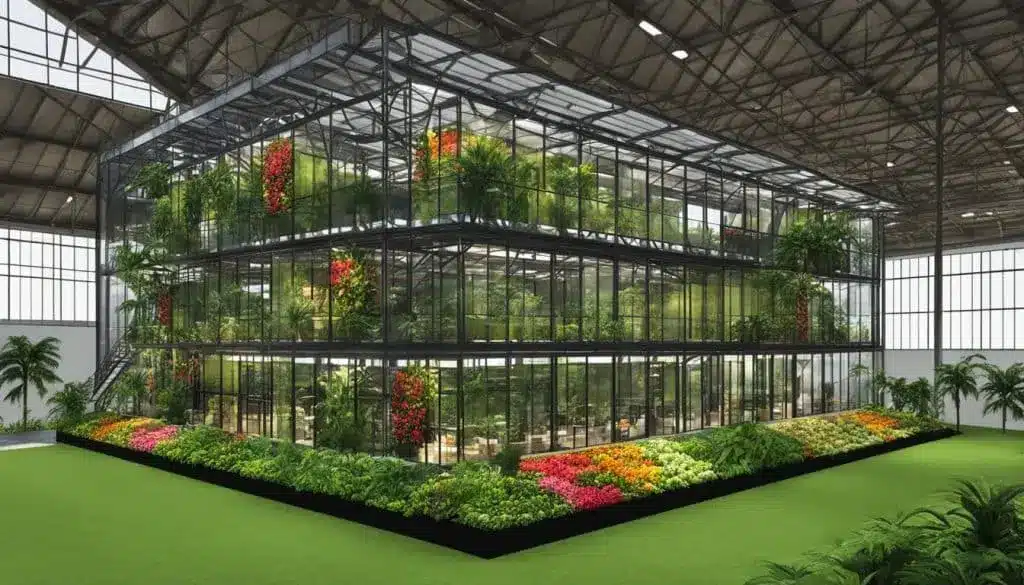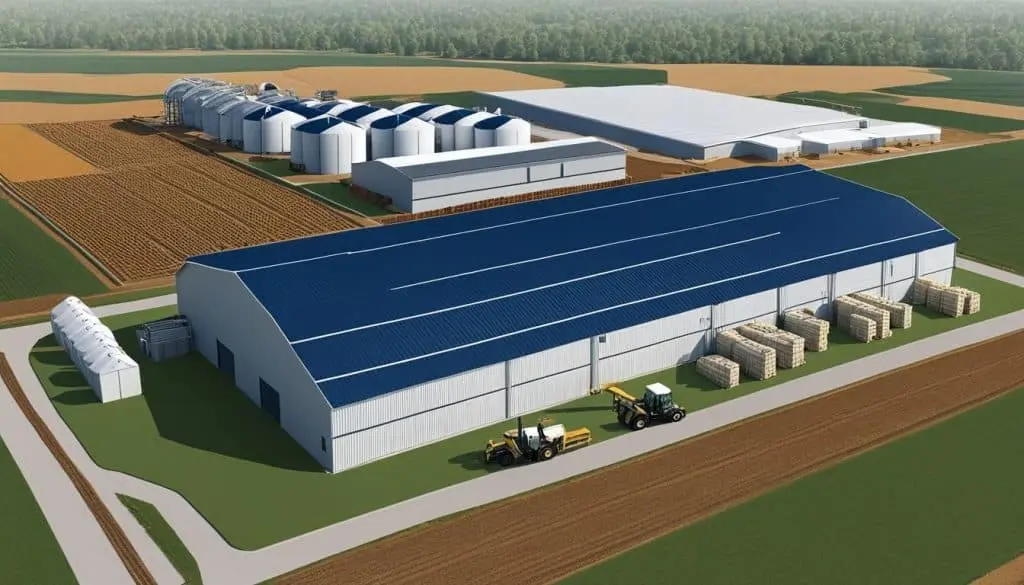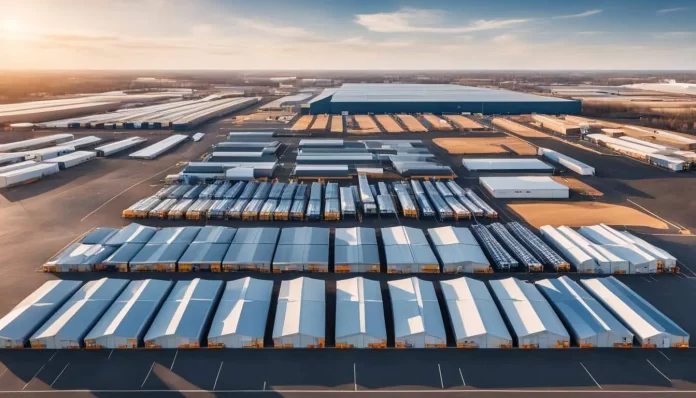Welcome to our comprehensive exploration of regional warehouse types, where we dive into the diverse world of storage strategies across different regions. From urban to rural areas, warehouses come in various shapes and sizes, each with its unique characteristics and challenges. By understanding these regional differences, businesses like yours can optimize their storage, logistics, and supply chain strategies to gain a competitive edge.
Throughout this article, we will cover a range of topics, including warehouse diversity, the impact of local climate, the importance of location, and the adoption of technology in regional warehousing. Additionally, we will share case studies of innovative warehousing solutions implemented in various regions, providing practical insights and inspiration for your own warehouse initiatives.
So, get ready to explore the rich tapestry of regional warehouse types and discover how storage strategies vary from one location to another. Let’s dive in and unlock the secrets behind successful warehouse management in different regions around the Philippines.
Table of Contents

Overview of Warehouse Diversity Across the Philippines
In the diverse landscape of the Philippines, warehouses come in various shapes, sizes, and types to cater to the unique needs of different regions. The geographical factors, economic influences, and cultural practices of each area play a significant role in shaping the warehouse types found across the country.
Geographically, the location and terrain of a region greatly influence the design and functionality of its warehouses. In urban areas, warehouses are strategically positioned to be close to markets and transportation hubs, enabling efficient distribution and delivery processes. On the other hand, rural regions may have warehouses situated in agricultural or industrial areas, reflecting the specific needs and activities of those sectors.
Economically, the warehouse types in the Philippines are influenced by the industries present in each region. For example, warehouse facilities near ports and coastal areas cater to the country’s booming import and export trade. Agricultural provinces have warehouses specialized in storing crops, while industrial zones require warehouses equipped to handle machinery and heavy equipment. These economic factors shape the design, storage capacity, and logistical capabilities of warehouses in different regions.
Furthermore, cultural practices and business norms also contribute to the diversity of warehouse types across the Philippines. Factors like local customs, traditions, and regulations impact the design and operations of warehouses. For instance, warehouses in regions with a strong agricultural heritage may incorporate traditional storage techniques specific to crops unique to that area.
By understanding the warehouse diversity across the Philippines, businesses can adapt their logistics and storage strategies to the specific challenges and opportunities present in each region. Whether it’s locating warehouses in the right areas, designing facilities that meet geographical limitations, or aligning with local customs and practices, a comprehensive understanding of warehouse diversity is essential to successful operations in the country.
The Importance of Location in Warehouse Functionality
When it comes to warehouse functionality, location plays a vital role in optimizing supply chain management and streamlining operations. The strategic selection of warehouse locations can have a significant impact on minimizing transportation costs, reducing delivery times, and improving overall efficiency.
The proximity to suppliers, customers, transportation infrastructure, and key markets is crucial in determining the success of a warehouse. By being located closer to suppliers, businesses can reduce lead times and ensure timely replenishment of inventory. This not only enables smoother production processes but also helps to meet customer demands effectively.
Furthermore, being geographically close to customers allows businesses to provide faster and more cost-effective shipping options, leading to higher customer satisfaction and repeat business. This is particularly important in the e-commerce industry, where speedy delivery is a key competitive advantage.
Transportation infrastructure, such as highways, ports, and airports, also plays a significant role in warehouse functionality. A well-connected warehouse can facilitate the efficient movement of goods, reducing transportation costs and ensuring timely delivery. Proximity to key markets is another important consideration, as it allows businesses to respond quickly to market trends and changes in customer demands.
Businesses need to consider the accessibility and convenience of a warehouse’s location when making decisions about warehouse functionality. Conducting a thorough analysis of various factors, such as transportation networks, customer concentrations, and supplier locations, can help in determining the ideal location for a warehouse.
By strategically selecting warehouse locations based on these considerations, businesses can optimize their supply chain, reduce costs, and improve operational efficiency. This ultimately leads to better customer service, increased profitability, and a competitive edge in the market.
Urban vs Rural Warehouse Characteristics
In this section, we will compare and contrast the characteristics of urban and rural warehouses. Understanding the differences between these two types of warehouses is crucial for businesses to adapt their logistics strategies accordingly.
Urban warehouses are commonly found in metropolitan and urban areas, close to markets and transportation hubs. These warehouses are designed to facilitate efficient and timely distribution of goods to meet the demands of densely populated areas. They are often multi-story buildings or high-rise structures, maximizing vertical space to compensate for limited land availability. Urban warehouses focus on fast-moving inventory, utilizing advanced automation and technology to handle high volumes of orders.
Rural warehouses, on the other hand, have distinct features due to their location in less densely populated areas. These warehouses cater to the needs of rural communities and industries, such as agriculture, manufacturing, or natural resource extraction. Rural warehouses usually have more land available, allowing for larger storage facilities and outdoor storage yards. They often rely on traditional storage solutions, such as pallet racking and open-air storage, to accommodate the vast quantities of goods.
The utilization of different storage solutions is another differentiating characteristic of urban and rural warehouses. In urban warehouses, space optimization is critical, and therefore, they make use of conveyors, automated retrieval systems, and high-density storage systems, such as drive-in racks or mezzanine floor systems. On the other hand, rural warehouses typically have more land and can afford to utilize larger, more traditional storage solutions, such as bulk storage bins or silos for agricultural products.
The limited infrastructure in rural areas also impacts the characteristics of rural warehouses. Unlike urban areas, rural regions often have lower accessibility to transportation networks, making it challenging to transport goods to and from rural warehouses. Therefore, rural warehouses must consider transportation constraints and may require additional resources for storage and order fulfillment. This can include setting up satellite warehouses or implementing efficient transportation routes to overcome the limitations of rural infrastructure.
By understanding the distinct characteristics of urban and rural warehouses, businesses can tailor their storage and logistics strategies accordingly. Whether you operate in a bustling city or a rural region, considering these differences will help you optimize your warehouse operations to meet the specific demands of your location.
Challenges and Solutions for Tropical Cold Storage
In tropical regions like the Philippines, storing temperature-sensitive goods presents unique challenges. The hot and humid climate makes it difficult to maintain optimal temperature and humidity levels, which are crucial for preserving the quality of perishable goods. However, there are effective solutions that businesses can implement to overcome these challenges and ensure the integrity of their products.
To address the challenges of tropical cold storage, businesses can leverage advanced technologies and adopt best practices. For instance, the use of state-of-the-art refrigeration systems with precise temperature and humidity controls is essential. These systems ensure that perishable goods are kept at the ideal conditions throughout the storage period.
In addition to high-quality refrigeration equipment, proper insulation and ventilation are critical for tropical cold storage facilities. Insulation helps prevent heat transfer, while adequate ventilation helps to maintain air circulation and prevent moisture buildup. These measures contribute to preserving the freshness and quality of perishable goods.
Furthermore, implementing robust monitoring and alarm systems is crucial for maintaining cold storage integrity. Automated sensors and alarms can alert warehouse operators when temperature or humidity levels deviate from the desired range. This enables timely intervention to address any issues before they compromise the quality of the stored goods.
Another key aspect of tropical cold storage is proper inventory management. Implementing a reliable tracking system allows businesses to ensure proper rotation of stock and minimize waste. Additionally, effective labeling and segregation practices can help prevent cross-contamination and ensure the accurate retrieval of products when needed.
In summary, tropical cold storage poses unique challenges due to the hot and humid climate. However, businesses can overcome these challenges by investing in advanced refrigeration technology, implementing proper insulation and ventilation, utilizing robust monitoring systems, and ensuring efficient inventory management. By implementing these solutions, businesses can navigate the complexities of tropical cold storage and ensure the preservation and quality of their perishable goods in the Philippines and other tropical regions.
Specialized Warehouses in Different Regions
In this section, we will explore specialized warehouses found in different regions. Understanding the specific requirements and features of these warehouses is crucial for businesses to make informed decisions when it comes to storage and logistics planning.
Port-Adjacent and Coastal Warehousing
Port-adjacent and coastal warehouses offer unique advantages and challenges. Being located near ports allows for efficient transportation and easy access to imported and exported goods. Coastal warehouses provide proximity to waterways, enabling smooth distribution to coastal areas. However, these locations may face increased vulnerability to natural disasters such as typhoons and rising sea levels. Businesses operating in these specialized warehouses need to consider risk management strategies while capitalizing on the proximity to transportation hubs.
Agricultural Warehouses in Key Provinces
Key provinces in the Philippines have a strong agricultural sector, requiring specialized warehouses to store crops, livestock, and farming equipment. These warehouses are designed to maintain optimal conditions for different types of agricultural produce, ensuring freshness and quality. With proper temperature control, ventilation, and storage systems, agricultural warehouses play a crucial role in supporting the agriculture industry’s storage needs in key provinces.
Industrial Warehouses
Industrial warehouses cater to the unique requirements of different industries, such as manufacturing, mining, and construction. These warehouses are designed to accommodate large equipment, machinery, raw materials, and finished products. With spacious layouts and durable infrastructure, industrial warehouses provide ample storage space and facilitate efficient workflow for industry-specific operations.
When exploring regional differences in warehouse types, businesses need versatile and adaptable solutions to meet diverse requirements. HashMicro ERP software is designed to accommodate these variations efficiently. With customizable modules, real-time inventory tracking, and advanced analytics, HashMicro ensures seamless warehouse management across different regions.
Whether dealing with standard, climate-controlled, or automated warehouses, HashMicro ERP software provides the necessary tools for optimizing operations, reducing costs, and enhancing productivity. Experience the benefits firsthand by requesting a free demo today and see how HashMicro can transform your warehouse management.

Impact of Local Climate on Warehouse Design
In the Philippines, the impact of the local climate on warehouse design is a crucial consideration for businesses. The tropical climate poses unique challenges, such as high temperatures, humidity, and the potential for extreme weather events like typhoons.
These climate conditions necessitate the adaptation of warehouse facilities to ensure the safety, functionality, and longevity of stored goods. To address these challenges, warehouses in the Philippines incorporate specific design features and utilize advanced technologies.

One primary aspect of tropical warehouse adaptation is the implementation of sustainable cooling and ventilation systems. Energy-efficient cooling technologies and proper air circulation help maintain optimal temperature and humidity levels, preserving the quality and integrity of goods, especially perishable items.
Additionally, warehouses in the Philippines focus on building resilience in their design and construction to withstand extreme weather patterns. Reinforced structures, storm-resistant roofing, and flood mitigation measures are essential in areas prone to typhoons and flooding.
To further ensure resilience, warehouses implement robust disaster response plans and invest in backup power systems, such as generators and renewable energy sources, to maintain operations during unforeseen events.
As climate change continues to impact weather patterns, it is crucial for businesses to consider the long-term sustainability and adaptability of their warehouse design. By embracing innovative technologies and incorporating climate resilience strategies, businesses can future-proof their warehouses and mitigate the risks associated with changing weather patterns.
In conclusion, understanding the impact of the local climate on warehouse design is vital in the Philippines. Through tropical warehouse adaptation and prioritizing resilience in the face of diverse weather patterns, businesses can optimize their warehouse operations and ensure the safe storage and efficient distribution of goods.
Technological Adoption in Regional Warehousing
In today’s rapidly evolving business landscape, the adoption of technology has become a key driver in the optimization of warehouse operations. This section will explore the advancements in technology that are shaping regional warehousing practices, with a focus on both urban and rural areas.
In urban warehouses, technology has revolutionized the way goods are stored, managed, and distributed. Automation, robotics, and data-driven systems have greatly improved efficiency and accuracy in picking, sorting, and inventory management. With automated processes and advanced warehouse management systems, businesses can meet the demands of high-volume distribution while minimizing errors and reducing labor costs.
However, integrating technology in rural warehouses presents unique challenges due to limited infrastructure and resources. While technological advancements may be more challenging to implement in these areas, they also offer significant opportunities for improvement. By leveraging technology, rural warehouses can overcome constraints, enhance productivity, and streamline operations.
One of the key challenges in rural warehouse tech integration is the availability and reliability of internet connectivity. Without a stable internet connection, cloud-based systems and real-time data access may be limited. However, emerging technologies such as edge computing and local network solutions are addressing this challenge, enabling rural warehouses to leverage technology without relying heavily on internet connectivity.
Technological adoption in rural warehouses, such as using agriculture software, can bring several benefits. By implementing data-driven systems, businesses can gain valuable insights into their operations and optimize resource allocation. Additionally, technology can improve inventory accuracy, reduce stockouts, and enhance order fulfillment capabilities. By embracing technology, rural warehouses can bridge the gap with their urban counterparts and compete on a more level playing field.
In conclusion, the adoption of technology in regional warehousing is transforming the way businesses operate their warehouses. While urban warehouses are at the forefront of technological advancements, rural warehouses also have the opportunity to embrace technology and improve their operations. By investing in technological solutions, businesses can enhance efficiency, accuracy, and productivity in their warehouse operations, regardless of the region they are located in.
Case Studies: Innovative Warehousing Solutions in Various Regions
In this section, we will present case studies of innovative warehousing solutions implemented in various regions. These success stories from Luzon, Visayas, and Mindanao highlight how businesses have overcome regional challenges and optimized their warehouse operations.
One case study showcases a company in Luzon that implemented automated storage and retrieval systems (AS/RS) to increase efficiency and reduce labor costs. By adopting this innovative solution, the company was able to significantly improve their order fulfillment process and minimize errors.
In another case study from Visayas, a company successfully implemented a regional warehouse strategy by strategically distributing their inventory across multiple warehouses. This approach allowed them to streamline their supply chain and achieve faster delivery times to their customers in different regions.
In Mindanao, a company faced unique challenges due to the region’s remote location and limited infrastructure. To overcome these obstacles, they implemented a cloud-based warehouse management system (WMS) that allowed them to effectively manage inventory, streamline operations, and make data-driven decisions.
From these case studies, we can draw valuable lessons and insights into effective regional warehousing strategies. Businesses can learn from these real-world examples and apply the best practices to optimize their own warehouse operations. By embracing innovative solutions, companies can improve productivity, reduce costs, and enhance customer satisfaction.
Diversity of Warehousing in Response to Agricultural Demands
Agriculture plays a vital role in the Philippines, and the warehousing sector has evolved to meet the specific demands and challenges faced by the agricultural industry. From storing crops to handling equipment and machinery, agricultural warehousing requires unique storage solutions that cater to the specific needs of this sector.

One of the key considerations in agricultural warehousing is the storage of perishable crops. These crops require specialized facilities that can maintain optimal temperature and humidity levels to ensure their freshness and quality. Cold storage solutions, such as refrigerated warehouses and controlled atmosphere storage, are essential for preserving crops such as fruits, vegetables, and flowers.
In addition to perishable crops, agricultural warehousing also involves the storage of equipment and machinery. Farming equipment, such as tractors, harvesters, and irrigation systems, require proper storage to prevent damage and ensure their longevity. Warehouses designed for agricultural equipment may include features such as large entrances, high ceilings, and ample space for maneuvering these bulky and heavy items.
Furthermore, agricultural warehousing demands efficient inventory management systems to track and organize different types of agricultural products. From seeds and fertilizers to livestock feed, effective storage strategies are necessary to ensure proper handling and timely distribution of these items.
The agricultural sector also relies on efficient logistics and transportation networks to move products from farms to warehouses and then to market. Warehouses located strategically near farming areas and major transportation hubs can facilitate the smooth flow of goods, minimizing delays and ensuring timely delivery.
By understanding the unique demands of warehousing in the agricultural sector, businesses can develop tailored storage solutions that optimize efficiency and support the growth of this important industry. From specialized facilities for perishable crops to dedicated spaces for equipment and machinery, agricultural warehousing plays a critical role in ensuring a sustainable and productive agricultural sector in the Philippines.
Future Trends in Regional Warehousing Developments
In this final section, we will explore the future trends in regional warehousing developments. As the logistics landscape continues to evolve, it is essential for businesses in the Philippines to stay informed and adapt their warehouse strategies to remain competitive.
One of the emerging trends in regional warehousing is the increasing adoption of advanced technology. Urban and rural areas alike are leveraging automation, robotics, and data-driven systems to enhance efficiency and productivity.
Another significant trend is the growing importance of sustainability practices. Businesses are recognizing the need to minimize their environmental impact and are implementing eco-friendly initiatives such as renewable energy sources, waste reduction, and efficient packaging solutions.
Furthermore, there are changes in warehouse needs driven by shifts in consumer behavior and industry dynamics. With the rise of e-commerce and the demand for faster order fulfillment, warehouses are evolving to become more agile, flexible, and capable of handling last-mile deliveries efficiently.
By keeping an eye on these future trends in regional warehousing developments, businesses in the Philippines can position themselves for success and ensure their warehouse strategies are aligned with the evolving needs of the industry.



































